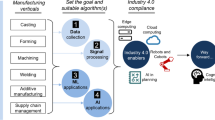Abstract
This chapter presents the concepts and philosophy underlying an intelligent product design and manufacturing (IPDM) system developed at the Centre for Flexible Manufacturing Research and Development at McMaster University. The overall objective of the IPDM research program is to: (1) investigate the basic issues involved in integrating the design and manufacturing task planning activities; and (2) demonstrate the feasibility and potential of applying artificial intelligence, expert systems and feature-based modelling concepts to these activities. The project addresses the fundamental problem(s) of establishing an effective link between computer-aided design (CAD) and manufacture (CAM).
Access this chapter
Tax calculation will be finalised at checkout
Purchases are for personal use only
Preview
Unable to display preview. Download preview PDF.
Similar content being viewed by others
References
Shah JJ, Rogers MT. Expert form feature modelling shell. Comput Aided Des 1988; 20: 515–524
PDES form features information model; version 4 (draft), National Institute of Standards and Technology report, August 1988
ElMaraghy HA, Gu PH. Expert tolerancing consultant for geometric modelling. Proceedings ASME manufacturing international ’88, Atlanta, Georgia, Product and process design Symposium, pp 17–22
Liu YC, ElMaraghy HA, Zhang KF. An expert systems for forming quadrilateral finite elements. Eng Comput, in press
ElMaraghy HA, Knoll L. IPDM — Intelligent product design and manufacture. Proceedings MAPLE 1990, Ottawa, Canada, pp 67–79
Gu PH, ElMaraghy HA, Hamid L. FDDL: A feature-based design description language. Proceedings ASME 1st design methodology conference, Montreal, Canada, 1989, pp 53–63
Pfaff T, ElMaraghy HA. Part definition language — PDL, FMRD report no. 5, Centre for Flexible Manufacturing Research and Development, McMaster University, Canada, 1988
Weil R, Spur G, Eversheim W. Survey of computer aided process planning systems. Ann CIRP 1982; 31: 539
Eversheim W. Survey of computer-aided process planning systems. CIRP Tech. Reports, The CIRP Annals, pp 407–611, 1985
Phillips R, Zhou X, Mouluswaran C. An artificial intelligence approach to integrating CAD and CAM through generative process planning. Proceedings ASME international computers in engineering conference, pp 459–463, 1984
Ham I, Lu S. Computer aided process planning: the present and future. Ann CIRP 1988; 37: pp 591–601
Proceedings 19th CIRP international seminar on manufacturing systems (major theme: CAPP). The Pennsylvania State University, 1987
ElMaraghy HA, Gu PH. Expert system for inspection planning. Ann CIRP 1987; 36: 85–89
Fu KS. Syntactical pattern recognition, theory and applications. Prentice Hall, Englewood Cliffs, NJ, 1982
Bourjault A. Contribution à une approche méthodologique de l’assemblage automatisé: elaboration automatique des séquences opératories, Thèse d’État, Université de Besançon Franche-Comté, France, 1984
Whitney DE et al. Computer aided design of flexible assembly systems, report no. CDSL-R-2033, Charles Draper Laboratory, MIT, Cambridge, MA, 1988
Homem de Mello LS, Sanderson AC. Automatic generation of mechanical assembly sequences. CMU-RI-TR-88-19 report, The Robotics Institute, Carnegie-Mellon University, Pittsburgh, PA, 1988
Laperriere L, ElMaraghy HA. An assembly sequence generator. Proceedings ASME flexible assembly conference, Montreal, Canada, 1989, pp 15–22
Rondeau JM, ElMaraghy HA. ROBOPLAN — intelligent task planner for robotic assembly. Proceedings ASME flexible assembly conference, Montreal, Canada, 1989, pp 23–30
ElMaraghy HA, Hamid L, ElMaraghy WH. ROBOCELL: a computer-aided robots modelling and workstation layout system. Int J Adv Manuf Technol 1987; 2: 43–59
ElMaraghy HA, Gu P. Knowledge-based system for assignment of parts to machine cells. Int J Adv Manuf Technol 1988; 3: 33–44
Editor information
Editors and Affiliations
Rights and permissions
Copyright information
© 1991 Springer-Verlag London Limited
About this chapter
Cite this chapter
ElMaraghy, H.A. (1991). Intelligent Product Design and Manufacture. In: Pham, D.T. (eds) Artificial Intelligence in Design. Artificial Intelligence in Industry Series. Springer, Berlin, Heidelberg. https://doi.org/10.1007/978-3-642-74354-2_7
Download citation
DOI: https://doi.org/10.1007/978-3-642-74354-2_7
Publisher Name: Springer, Berlin, Heidelberg
Print ISBN: 978-3-642-74356-6
Online ISBN: 978-3-642-74354-2
eBook Packages: Springer Book Archive




